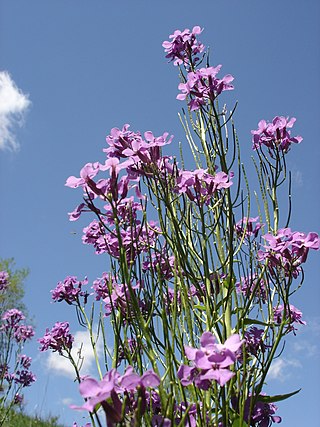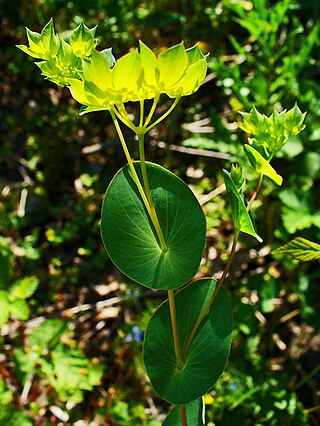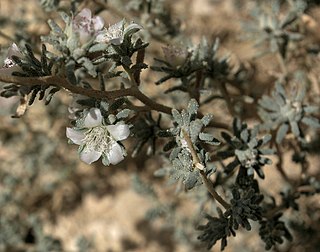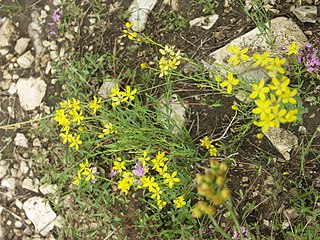
Genista is a genus of flowering plants in the legume family Fabaceae, native to open habitats such as moorland and pasture in Europe and western Asia. They include species commonly called broom, though the term may also refer to other genera, including Cytisus and Chamaecytisus. Brooms in other genera are sometimes considered synonymous with Genista: Echinospartum, Retama, Spartium, Stauracanthus, and Ulex.

Hesperis is a genus of flowering plants in the family Brassicaceae. Most are native to Eurasia, with several endemic to Greece and Turkey. Many plants of this genus bear showy, fragrant flowers in shades of purple and white. One of the more widely known species is the common garden flower Hesperis matronalis. The genus name Hesperis was probably given because the scent of the flowers becomes more conspicuous towards evening.

Bupleurum is a large genus of annual or perennial herbs or woody shrubs, with about 190 species, belonging to the family Apiaceae. The full size of its species may vary between a few cm to up to 3 m high. Their compound umbels of small flowers are adorned with bracteoles that are sometimes large and may play a role in attracting pollinators. Rare among the Apiaceae are the simple leaves, bracts, and bracteoles. The genus is almost exclusively native in the Old World Northern Hemisphere, with one species native to North America and one species native to southern Africa.

Trigonella is a genus from the family Fabaceae. The best known member is the herb fenugreek. Members of the genus occur naturally in the Canary Islands, southern Europe, non‑tropical Africa, western and central Asia, the Indian subcontinent, and Australia.

Ballota (horehound) is a genus of flowering evergreen perennial plants and subshrubs in the family Lamiaceae. native to temperate regions. The Mediterranean region has the highest diversity in the genus, with more isolated locations in South Africa, Central Asia, northern Europe, and the islands of the eastern North Atlantic. It is found in rocky and waste ground.

Alyssum is a genus of over a hundred species of flowering plants in the family Brassicaceae, native to Europe, Asia, and northern Africa, with the highest species diversity in the Mediterranean region. The genus comprises annual and perennial herbaceous plants or (rarely) small shrubs, growing to 10–100 cm tall, with oblong-oval leaves. Alyssum flowers are characteristically small and grouped in terminal clusters; they are often yellow or white colored but can be pink or purple.

Asperula, commonly known as woodruff, is a genus of flowering plants in the family Rubiaceae. It contains 91 species and has a wide distribution area from Europe, northern Africa, temperate and subtropical Asia to Australasia.

Alkanna is a genus of herbaceous plants in the family Boraginaceae. It includes 66 species native to southern and east-central Europe, western Asia, and North Africa.

Jurinea is a genus of flowering plants in the family Asteraceae.

Fumana is a small genus of flowering plants in the family Cistaceae. They are small perennial shrubs with five-lobed yellow flowers, native to rocky and sandy soils of Europe and wider Mediterranean region. Fumana shrubs can be procumbent or erect. Leaves tend to be very narrow and are almost always alternate.

Reaumuria is a genus of flowering plants in the family Tamaricaceae, found in North Africa, Sicily, Anatolia, the Middle East, the Caucasus, Pakistan, Central Asia, Mongolia, Tibet, and northern China. They tend to be perennial xerophytic and halophytic shrubs or subshrubs.

Psephellus is a genus of flowering plants in the tribe Cardueae within the family Asteraceae, native to eastern Europe and western Asia. A taxonomic revision reassigned many species from Centaurea to Psephellus.
Bolanthus is a genus of flowering plants belonging to the family Caryophyllaceae. It includes 21 species native to the eastern Mediterranean, from Greece to the Sinai Peninsula.

Haplophyllum is a genus of flowering plants belonging to the family Rutaceae. It is the only genus in the subfamily Haplophylloideae.













